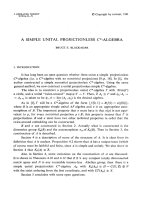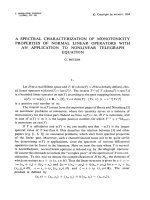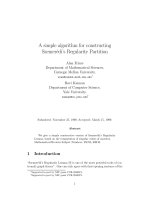Báo cáo toán học: "A Simple Proof of the Aztec Diamond Theorem" potx
Bạn đang xem bản rút gọn của tài liệu. Xem và tải ngay bản đầy đủ của tài liệu tại đây (102.52 KB, 8 trang )
A Simple Proof of the Aztec Diamond Theorem
Sen-Peng Eu
∗
Department of Applied Mathematics
National University of Kaohsiung
Kaohsiung 811, Taiwan, ROC
Tung-Shan Fu
†
Mathematics Faculty
National Pingtung Institute of Commerce
Pingtung 900, Taiwan, ROC
Submitted: Apr 5, 2004; Accepted: Apr 8, 2005; Published: Apr 20, 2005
Mathematics Subject Classifications: 05A15; 05B45; 05C50; 05C20
Abstract
Based on a bijection between domino tilings of an Aztec diamond and non-
intersecting lattice paths, a simple proof of the Aztec diamond theorem is given by
means of Hankel determinants of the large and small Schr¨oder numbers.
Keywords: Aztec diamond, domino tilings, Hankel matrices, Schr¨oder numbers, lattice
paths
1 Intro duction
The Aztec diamond of order n, denoted by AD
n
, is defined as the union of all the unit
squares with integral corners (x, y) satisfying |x| + |y|≤n +1. A domino is simply a
1-by-2 or 2-by-1 rectangle with integral corners. A domino tiling of a region R is a set of
non-overlapping dominoes the union of which is R. Figure 1 shows the Aztec diamond
of order 3 and a domino tiling. The Aztec diamond theorem, first proved by Elkies et
al. in [4], states that the number a
n
of domino tilings of the Aztec diamond of order n is
2
n(n+1)/2
. They give four proofs, relating the tilings in turn to alternating sign matrices,
∗
Partially supported by National Science Council, Taiwan, ROC (NSC 93-2115-M-390-005).
†
Partially supported by National Science Council, Taiwan, ROC (NSC 93-2115-M-251-001).
the electronic journal of combinatorics 12 (2005), #R18 1
monotone triangles, representations of general linear groups, and domino shuffling. Other
approaches to this theorem appear in [2, 3, 6]. Ciucu [3] derives the recurrence relation
a
n
=2
n
a
n−1
by means of perfect matchings of cellular graphs. Kuo [6] develops a method,
called graphical condensation, to derive the recurrence relation a
n
a
n−2
=2a
2
n−1
, for n ≥ 3.
Recently, Brualdi and Kirkland [2] give a proof by considering a matrix of order n(n +1)
the determinant of which gives a
n
. Their proof is reduced to the computation of the
determinant of a Hankel matrix of order n that involves large Schr¨oder numbers. In this
note we give a proof by means of Hankel determinants of the large and small Schr¨oder
numbers based on a bijection between the domino tilings of an Aztec diamond and non-
intersecting lattice paths.
Figure 1: The AD
3
and a domino tiling
The large Schr¨oder numbers {r
n
}
n≥0
:= {1, 2, 6, 22, 90, 394, 1806, } and the small
Schr¨oder numbers {s
n
}
n≥0
:= {1, 1, 3, 11, 45, 197, 903, } are registered in Sloane’s On-
Line Encyclopedia of Integer Sequences [7], namely A006318 and A001003, respectively.
Among many other combinatorial structures, the nth large Schr¨oder number r
n
counts
the number of lattice paths in the plane Z × Z from (0, 0) to (2n, 0) using up steps (1, 1),
down steps (1, −1), and level steps (2, 0) that never pass below the x-axis. Such a path is
called a larg e Schr¨oder path of length n (or a large n-Schr¨oder path for short). Let U, D,
and L denote an up, down, and level step, respectively. Note that the terms of {r
n
}
n≥1
are twice of those in {s
n
}
n≥1
. It turns out that the nth small Schr¨oder number s
n
counts
the number of large n-Schr¨oder paths without level steps on the x-axis, for n ≥ 1. Such
a path is called a small n-Schr¨oder path. Refer to [8, Exercise 6.39] for more information.
Our proof relies on the determinants of the following Hankel matrices of the large and
small Schr¨oder numbers
H
(1)
n
:=
r
1
r
2
··· r
n
r
2
r
3
··· r
n+1
.
.
.
.
.
.
.
.
.
r
n
r
n+1
··· r
2n−1
,G
(1)
n
:=
s
1
s
2
··· s
n
s
2
s
3
··· s
n+1
.
.
.
.
.
.
.
.
.
s
n
s
n+1
··· s
2n−1
.
Making use of a method of Gessel and Viennot [5], we associate the determinants of H
(1)
n
and G
(1)
n
with the numbers of n-tuples of non-intersecting large and small Schr¨oder paths,
respectively. Note that H
(1)
n
=2G
(1)
n
. This relation bridges the recurrence relation (2)
the electronic journal of combinatorics 12 (2005), #R18 2
that leads to the result det(H
(1)
n
)=2
n(n+1)/2
as well as the number of the required n-
tuples of non-intersecting large Schr¨oder paths (see Proposition 2.1). Our proof of the
Aztec diamond theorem is completed by a bijection between domino tilings of an Aztec
diamond and non-intersecting large Schr¨oder paths (see Proposition 2.2).
We remark that Brualdi and Kirkland [2] use an algebraic method, relying on a J-
fraction expansion of generating functions, to evaluate the determinant of a Hankel matrix
of large Schr¨oder numbers. Here we use a combinatorial approach that simplifies the
evaluation of the Hankel determinants of large and small Schr¨oder numbers significantly.
2 A proof of the Aztec diamond theorem
Let Π
n
(resp. Ω
n
)denotethesetofn-tuples (π
1
, ,π
n
) of large Schr¨oder paths (resp.
small Schr¨oder paths) satisfying the following two conditions.
(A1) Each path π
i
goes from (−2i +1, 0) to (2i − 1, 0), for 1 ≤ i ≤ n.
(A2) Any two paths π
i
and π
j
do not intersect.
There is an immediate bijection φ between Π
n−1
and Ω
n
, for n ≥ 2, which carries
(π
1
, ,π
n−1
) ∈ Π
n−1
into φ((π
1
, ,π
n−1
)) = (ω
1
, ,ω
n
) ∈ Ω
n
,whereω
1
= UD and
ω
i
= UUπ
i−1
DD (i.e., ω
i
is obtained from π
i−1
with 2 up steps attached in the beginning
and 2 down steps attached in the end, and then rises above the x-axis), for 2 ≤ i ≤ n.For
example, on the left of Figure 2 is a triple (π
1
,π
2
,π
3
) ∈ Π
3
. The corresponding quadruple
(ω
1
,ω
2
,ω
3
,ω
4
) ∈ Ω
4
is shown on the right. Hence, for n ≥ 2, we have
|Π
n−1
| = |Ω
n
|. (1)
π
2
π
3
π
4
ω
3
ω
2
ω
1
ω
1
π
2
π
3
π
1
−3 −1
1
3
5
−5
−7
−
3
−1
13
5
7
−5
Figure 2: Atriple(π
1
,π
2
,π
3
) ∈ Π
3
and the corresponding quadruple (ω
1
,ω
2
,ω
3
,ω
4
) ∈ Ω
4
For a permutation σ = z
1
z
2
···z
n
of {1, ,n},thesign of σ, denoted by sgn(σ), is
defined by sgn(σ):=(−1)
inv(σ)
,whereinv(σ):=Card{(z
i
,z
j
)| i<jand z
i
>z
j
} is the
number of inversions of σ.
the electronic journal of combinatorics 12 (2005), #R18 3
Using the technique of a sign-reversing involution over a signed set, we prove that the
cardinalities of Π
n
and Ω
n
coincide with the determinants of H
(1)
n
and G
(1)
n
, respectively.
Following the same steps as [9, Theorem 5.1], a proof is given here for completeness.
Proposition 2.1 For n ≥ 1, we have
(i) |Π
n
| =det(H
(1)
n
)=2
n(n+1)/2
, and
(ii) |Ω
n
| =det(G
(1)
n
)=2
n(n−1)/2
.
Proof: For 1 ≤ i ≤ n,letA
i
denote the point (−2i +1, 0) and let B
i
denote the point
(2i − 1, 0). Let h
ij
denote the (i, j)-entry of H
(1)
n
.Notethath
ij
= r
i+j−1
is equal to
the number of large Schr¨oder paths from A
i
to B
j
.LetP be the set of ordered pairs
(σ, (τ
1
, ,τ
n
)), where σ is a permutation of {1, ,n},and(τ
1
, ,τ
n
)isann-tuple of
large Schr¨oder paths such that τ
i
goes from A
i
to B
σ(i)
. According to the sign of σ,the
ordered pairs in P are partitioned into P
+
and P
−
.Then
det(H
(1)
n
)=
σ∈S
n
sgn(σ)
n
i=1
h
i,σ(i)
= |P
+
|−|P
−
|.
We show that there exists a sign-reversing involution ϕ on P , in which case det(H
(1)
n
)is
equal to the number of fixed points of ϕ.Let(σ, (τ
1
, ,τ
n
)) ∈ P be such a pair that
at least two paths of (τ
1
, ,τ
n
) intersect. Choose the first pair i<jin lexicographical
order such that τ
i
intersects τ
j
. Construct new paths τ
i
and τ
j
by switching the tails after
the last point of intersection of τ
i
and τ
j
.Nowτ
i
goes from A
i
to B
σ(j)
and τ
j
goes from
A
j
to B
σ(i)
.Sinceσ ◦ (ij) carries i into σ(j), j into σ(i), and k into σ(k), for k = i, j,we
define
ϕ((σ, (τ
1
, ,τ
n
))) = (σ ◦ (ij), (τ
1
, ,τ
i
, ,τ
j
, ,τ
n
)).
Clearly, ϕ is sign-reversing. Since this first intersecting pair i<jof paths is not affected
by ϕ, ϕ is an involution. The fixed points of ϕ are the pairs (σ, (τ
1
, ,τ
n
)) ∈ P ,where
τ
1
, ,τ
n
do not intersect. It follows that τ
i
goes from A
i
to B
i
, for 1 ≤ i ≤ n (i.e., σ is
the identity) and (τ
1
, ,τ
n
) ∈ Π
n
. Hence det(H
(1)
n
)=|Π
n
|. By the same argument, we
have det(G
(1)
n
)=|Ω
n
|. It follows from (1) and the relation H
(1)
n
=2G
(1)
n
that
|Π
n
| =det(H
(1)
n
)=2
n
· det(G
(1)
n
)=2
n
|Ω
n
| =2
n
|Π
n−1
|. (2)
Note that |Π
1
| = 2, and hence, by induction, assertions (i) and (ii) follow.
To prove the Aztec diamond theorem, we shall establish a bijection between Π
n
and
the set of domino tilings of AD
n
based on an idea, due to D. Randall, mentioned in [8,
Solution of Exercise 6.49].
the electronic journal of combinatorics 12 (2005), #R18 4
Proposition 2.2 There is a bijection between the set of domino tilings of the Aztec di-
amond of order n and the set of n-tuples (π
1
, ,π
n
) of large Schr¨oder paths satisfying
conditions (A1) and (A2).
Proof: Given a tiling T of AD
n
, we associate T with an n-tuple (τ
1
, ,τ
n
)ofnon-
intersecting paths as follows. Let the rows of AD
n
be indexed by 1, 2, ,2n from bottom
to top. For each i,(1≤ i ≤ n) we define a path τ
i
from the center of the left-hand edge of
the ith row to the center of the right-hand edge of the ith row. Namely, each step of the
path is from the center of a domino edge (where a domino is regarded as having six edges
of unit length) to the center of another edge of the some domino D, such that the step
is symmetric with respect to the center of D. One can check that for each tiling there
is a unique such an n-tuple (τ
1
, ,τ
n
) of paths, moreover, any two paths τ
i
, τ
j
of which
do not intersect. Conversely, any such n-tuple of paths corresponds to a unique domino
tiling of AD
n
.
Let Λ
n
denote the set of such n-tuples (τ
1
, ,τ
n
) of non-intersecting paths associated
with domino tilings of AD
n
. We shall establish a bijection ψ between the set of domino
tilings of AD
n
to Π
n
with Λ
n
as the intermediate stage. Given a tiling T of AD
n
,let
(τ
1
, ,τ
n
) ∈ Λ
n
be the n-tuple of paths associated with T . The mapping ψ is defined
by carrying T into ψ(T )=(π
1
, ,π
n
), where π
i
= U
1
···U
i−1
τ
i
D
i−1
···D
1
(i.e., the large
Schr¨oder path π
i
is obtained from τ
i
with i − 1 up steps attached in the beginning of
τ
i
and with i − 1 down steps attached in the end, and then rises above the x-axis), for
1 ≤ i ≤ n. One can verify that π
1
, ,π
n
satisfy conditions (A1) and (A2), and hence
ψ(T ) ∈ Π
n
.
To find ψ
−1
,given(π
1
, ,π
n
) ∈ Π
n
, we can recover an n-tuple (τ
1
, ,τ
n
) ∈ Λ
n
of
non-intersecting paths from (π
1
, ,π
n
) by a reverse procedure. Then we retrieve the
required domino tiling ψ
−1
((π
1
, ,π
n
)) of AD
n
from (τ
1
, ,τ
n
).
For example, on the left of Figure 3 is a tiling T of AD
3
and the associated triple
(τ
1
,τ
2
,τ
3
) of non-intersecting paths. On the right of Figure 3 is the corresponding triple
ψ(T )=(π
1
,π
2
,π
3
) ∈ Π
3
of large Schr¨oder paths.
−
5
π
2
π
τ
2
τ
3
τ
1
1
π
τ
1
τ
2
τ
3
1
35
−1−
3
3
Figure 3: A tiling of AD
3
and the corresponding triple of non-intersecting Schr¨oder paths
By Propositions 2.1 and 2.2, we deduce the Aztec diamond theorem anew.
the electronic journal of combinatorics 12 (2005), #R18 5
Theorem 2.3 (Aztec diamond theorem) The number of domino tilings of the Aztec
diamond of order n is 2
n(n+1)/2
.
Remark: The proof of Proposition 2.1 relies on the recurrence relation Π
n
=2
n
Π
n−1
essentially, which is derived by means of the determinants of the Hankel matrices H
(1)
n
and G
(1)
n
. We are interested to hear a purely combinatorial proof of this recurrence relation.
In a similar manner we derive the determinants of the Hankel matrices of large and
small Schr¨oder paths of the forms
H
(0)
n
:=
r
0
r
1
··· r
n−1
r
1
r
2
··· r
n
.
.
.
.
.
.
.
.
.
r
n−1
r
n
··· r
2n−2
,G
(0)
n
:=
s
0
s
1
··· s
n−1
s
1
s
2
··· s
n
.
.
.
.
.
.
.
.
.
s
n−1
s
n
··· s
2n−2
.
Let Π
∗
n
(resp. Ω
∗
n
)bethesetofn-tuples (µ
0
,µ
1
, ,µ
n−1
) of large Schr¨oder paths
(resp. small Schr¨oder paths) satisfying the following two conditions.
(B1) Each path µ
i
goes from (−2i, 0) to (2i, 0), for 0 ≤ i ≤ n − 1.
(B2) Any two paths µ
i
and µ
j
do not intersect.
Note that µ
0
degenerates into a single point and that Π
∗
n
and Ω
∗
n
are identical since for
any (µ
0
,µ
1
, ,µ
n−1
) ∈ Π
∗
n
all of the paths µ
i
have no level steps on the x-axis. Moreover,
for n ≥ 2, there is a bijection ρ between Π
n−1
and Π
∗
n
that carries (π
1
, ,π
n−1
) ∈ Π
n−1
into ρ((π
1
, ,π
n−1
)) = (µ
0
,µ
1
, ,µ
n−1
) ∈ Π
∗
n
,whereµ
0
is the origin and µ
i
= Uπ
i
D,
for 1 ≤ i ≤ n − 1. Hence, for n ≥ 2, we have
|Π
∗
n
| = |Π
n−1
|. (3)
For example, on the left of Figure 4 is a triple (π
1
,π
2
,π
3
) ∈ Π
3
of non-intersecting large
Schr¨oder paths. The corresponding quadruple (µ
0
,µ
1
,µ
2
,µ
3
) ∈ Π
∗
4
is shown on the right.
3
π
2
π
3
π
3
µ
2
µ
1
µ
0
µ
1
π
2
π
1
π
−5 −3 −1
1
3
5
−6 −4 −2
0
2
46
Figure 4: Atriple(π
1
,π
2
,π
3
) ∈ Π
3
and the corresponding quadruple (µ
0
,µ
1
,µ
2
,µ
3
) ∈ Π
∗
4
By a similar argument to that of Proposition 2.1, we have det(H
(0)
n
)=|Π
∗
n
| = |Ω
∗
n
| =
det(G
(0)
n
). Hence, by (3) and Proposition 2.1(i), we have the following result.
the electronic journal of combinatorics 12 (2005), #R18 6
Proposition 2.4 For n ≥ 1, det(H
(0)
n
)=det(G
(0)
n
)=2
n(n−1)/2
.
Hankel matrices H
(0)
n
and H
(1)
n
may be associated with any given sequence of real
numbers. As noted by Aigner in [1, Section 1(D)] that the sequence of determinants
det(H
(0)
1
), det(H
(1)
1
), det(H
(0)
2
), det(H
(1)
2
),
uniquely determines the original number sequence provided that det(H
(0)
n
) =0and
det(H
(1)
n
) = 0, for all n ≥ 1, we have a characterization of large and small Schr¨oder
numbers.
Corollary 2.5 The following results hold.
(i) The large Schr¨oder numbers {r
n
}
n≥0
are the unique sequence with the Hankel deter-
minants det(H
(0)
n
)=2
n(n−1)/2
and det(H
(1)
n
)=2
n(n+1)/2
, for all n ≥ 1.
(ii) The small Schr¨oder numbers {s
n
}
n≥0
are the unique sequence with the Hankel de-
terminants det(G
(0)
n
)=det(G
(1)
n
)=2
n(n−1)/2
, for all n ≥ 1.
Acknowledgements
The authors would like to thank an anonymous referee for many helpful suggestions
that improve the presentation of this article.
References
[1] M. Aigner, Catalan and other numbers: a recurrent theme, pp. 347-390 in: Algebraic
Combinatorics and Computer Science, a tribute to Gian-Carlo Rota (H. Crapo and
D. Senato, eds.), Springer, Milano, 2001.
[2] R. A. Brualdi and S. Kirkland, Aztec diamonds and diagraphs, and Hankel determi-
nants of Schr¨oder numbers, J. Combin. T heory Ser. B,toappear.
[3] M. Ciucu, Perfect matchings of cellular graphs, J. Algebraic Combinatorics 5 (1996),
87–103.
[4] N. Elkies, G. Kuperberg, M. Larsen, and J. Propp, Alternating-sign matrices and
domino tilings (Part I), J. Algebraic Combinatorics 1 (1992), 111–132.
the electronic journal of combinatorics 12 (2005), #R18 7
[5] I. Gessel and G. Viennot, Binomial determinants, paths, and hook length formulae,
Advances in Math. 58 (1985), 300–321.
[6] E. H. Kuo, Applications of graphical condensation for enumerating matchings and
tilings, Theoret. Comput. Sci. 319 (2004), 29–57.
[7] N. J. A. Sloane, The On-Line Encyclopedia of Integer Sequences, published electron-
ically at />[8] R.P.Stanley,Enumerative Combinatorics, Vol. 2, Cambridge University Press, Cam-
bridge, 1999.
[9] D. Stanton and D. White, Constructive Combinatorics, Springer-Verlag, Berlin/Hei-
delberg/New York, 1986.
the electronic journal of combinatorics 12 (2005), #R18 8









